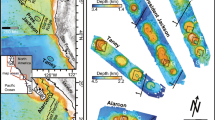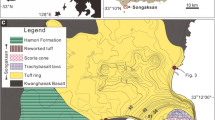Abstract
The majority of tephra generated during the paroxysmal 1883 eruption of Krakatau volcano, Indonesia, was deposited in the sea within a 15-km radius of the caldera. Two syneruptive pyroclastic facies have been recovered in SCUBA cores which sampled the 1883 subaqueous pyroclastic deposit. The most commonly recovered facies is a massive textured, poorly sorted mixture of pumice and lithic lapilli-to-block-sized fragments set in a silty to sandy ash matrix. This facies is indistinguishable from the 1883 subaerial pyroclastic flow deposits preserved on the Krakatau islands on the basis of grain size and component abundances. A less common facies consists of well-sorted, planarlaminated to low-angle cross-bedded, vitric-enriched silty ash. Entrance of subaerial pyroclastic flows into the sea resulted in subaqueous deposition of the massive facies primarily by deceleration and sinking of highly concentrated, deflated components of pyroclastic flows as they traveled over water. The basal component of the deposit suggests no mixing with seawater as inferred from retention of the fine ash fraction, high temperature of emplacement, and lack of traction structures, and no significant hydraulic sorting of components. The laminated facies was most likely deposited from low-concentration pyroclastic density currents generated by shear along the boundary between the submarine pyroclastic flows and seawater. The Krakatau deposits are the first well-documented example of true submarine pyroclastic flow deposition from a modern eruption, and thus constitute an important analog for the interpretation of ancient sequences where subaqueous deposition has been inferred based on the facies characteristics of encapsulating sedimentary sequences.
Similar content being viewed by others
References
Branney MJ (1991) Eruption and depositional facies of the Whorneyside Tuff Formation, English Lake District: an exceptionally large-magnitude phreatoplinian eruption. Geol Soc Am Bull 103:886–897
Carey S (1991) Transport and deposition of tephra by pyroclastic flows and surges In: Fisher RV, Smith G (eds.) Sedimentation in volcanic-settings. SEPM Spec Publ 45:39–57
Carey SN, Sigurdsson H (1980) The Roseau ash: deep-sea tephra deposits from a major eruption on the Island of Dominica, Lesser Antilles arc. J Volcanol Geotherm Res 7:67–86
Carey SN, Sigurdsson H, Mandeville C, Bronto S (1996) Pyroclastic flows and surges over water: an example from the 1883 Krakatau eruption. Bull Volcanol 57:493–511
Cas R, Wright JV (1987) Volcanic successions, modern and ancient. Allen and Unwin, Winchester, Mass
Cas R, Wright JV (1991) Subaqueous pyroclastic flows and ignimbrites: an assessment. Bull Volcanol 53:357–380
Cole RB, DeCelles PG (1991) Subaerial to submarine transitions in early Miocene pyroclastic flow deposits, southern San Joaquin basin, California. Geol Soc Am Bull 103:221–235
Deplus C, Bonvalot S, Dahrin D, Diament M, Harjono H, Dubois J (1995) Inner structure of the Krakatau volcanic complex (Indonesia) from gravity bathymetry data. J Volcanol Geotherm Res 64:23–52
Druitt TH, Sparks RSJ (1982) A proximal ignimbrite breccia facies on Santorini, Greece. J Volcanol Geotherm Res 13:147–171
Druitt TH, Bacon C (1986) Lithic breccia and ignimbrite erupted during collapse of Crater Lake Caldera, Oregon. J Volcanol Geotherm Res 29:1–32
Effendi AC, Sukhyar R, Bronto S (1986) Geologic map of Krakatau Volcano Complex Sunda Strait, Lampung Province. Volcanological Survey of Indonesia
Escher BG (1919) Veranderingen in de Krakatau Groep na 1908. In: Handelingen Eerste Nederlandsch-Indisch Natuuwetenschappelik Congres, Weltevreden, pp 198–219
Fierstein J, Nathanson M (1992) Another look at the calculation of fallout tephra volumes. Bull Volcanol 54:156–167
Folk RL (1974) Petrology of sedimentary rocks. Hemphill Publishing Co, Austin, Texas
Francis EH, Howells MF (1973) Transgressive welded ash-flow tuffs among the Ordovician sediments of NE Snowdonia. J Geol Soc Lond 129:621–641
Francis PW, Self S (1983) The eruption of Krakatau. Sci Am 249:172–187
Hampton MA (1972) The role of subaqueous debris flows in generating turbidity currents. J Sedimentol Petrol 42:775–793
Howells MF, Leveridge BE, Addison R, Evans CDR, Nutt MJC (1979) The Capel Curig volcanic formation, Snowdonia, North Wales; variations in ash-flow tuffs related to emplacement environment. In: Harris AL, Holland CH, Leake BE (eds) The Caledonides of the British Isles reviewed. Geol Soc Lond Spec Publ 8:611–618
Howells MF, Campbell DG, Reedman AJ (1985) Isolated pods of subaqueous welded ash-flow tuff: a distal facies of the Capel Curig volcanic formation (Ordovician), North Wales. Geol Mag 122:175–180
Inman DL (1952) Measures for describing the size distribution of sediments. J Sedimentol Petrol 22:125–145
Judd JW (1888) On the volcanic phenomena of the eruption, and on the nature and distribution of the ejected materials. In: Symons GJ (ed) The eruption of Krakatoa, and subsequent phenomena. Report of the Krakatoa Committee of the Royal Society, Trubner and Co, London, pp 1–56
Kano K (1990) An ash-flow tuff emplaced is shallow water, Early Miocene Koura formation, southwest Japan. J Volcanol Geotherm Res 40:1–9
Kienle J, Kowalik Z, Murty TS (1987) Tsunamis generated by eruptions form Mount St. Augustine Volcano, Alaska. Science 236:1442–1447
LaCroix A (1904) La montagne Pelée et ses éruptions. Masson, Paris
Mandeville CW (1995) Submarine pyroclastic deposits: implications for pyroclastic flow/seawater, interactions and volatile discharge during explosive volcanic eruptions. Ph. D. Dissertation, University of Rhode Island, Kingston, Rhode Island
Mandeville C, Carey S, Sigurdsson H (1991) Lithology, grain size and facies characteristics of submarine pyroclastic flow deposits from the 1883 eruption of Krakatau volcano, Indonesia. EOS 72 (17):296
Mandeville C, Carey S, Sigurdsson H, King J (1994) Paleomagnetic evidence for high temperature emplacement of the 1883 subaqueous pyroclastic flows from Krakatau volcano, Indonesia. J Geophys Res 99:9487–9504
Mandeville C, Carey S, Sigurdsson H (manuscript submitted) Magma mixing, fractional crystallization, and volatile discharge during the 1883 eruption of Krakatau volcano, Indonesia. J Volcanol Geotherm Res
McCoy FW, Cornell W (1990) Volcaniclastic sediments in the Tyrrhenian Basin. In: Kastens KA, Mascle J et al. (eds) 1990 Troc ODP, Sci Results, Tyrrhenian Sea, College Station, TX (Ocean Drilling Program) 107:291–305
McLeod N (1884) De uitbarsting van de Krakatau Tijdschrift van het Koniklijk Nederlansch Aardrijkskundig Genootschap (series 2) 1:184–191
McPhie J (1986) Primary and redeposited facies from a large-magnitude, rhyolitic, phreatomagmatic eruption: Cana Creek Tuff, Late Carboniferous, Australia. J Volcanol Geotherm Res 28:319–350
Moyer TC, Swanson DA (1987) Secondary hydroeruptions in pyroclastic-flow deposits: examples from Mount St. Helens. J Volcanol Geotherm Res 32:299–319
Orton GJ (1988) A spectrum of Middle Ordovician fan deltas and braidplain deltas: a consequence of varying fluvial clastic input. In: Nemec W, Steel R (eds) Fan deltas: sedimentology and tectonic settings. Blackie and Son, Glasgow, pp 23–49
Sarna-Wojcicki AM, Shipley S, Waitt RB Jr, Dzurisin D, Wood SH (1981) Areal distribution, thickness, mass, volume, and grain size of air-fall ash from the six major eruptions of 1980. In: Lipman PW, Mullineaux DR (eds) The 1980 eruptions of Mount St. Helens, Washington. US Geol Surv Prof Pap 1250:577–600
Self S (1983) Large-scale phreatomagmatic silicic volcanism: a case study from New Zealand. J Volcanol Geotherm Res 17:433–469
Self S (1992) Krakatau revisited: the course of events and interpretation of the 1883 eruption. Geo Journal 28–2:109–121
Self S, Rampino M (1981) The 1883 eruption of Krakatau. Nature 292:699–704
Sigurdsson H, Sparks RSJ, Carey S, Huang TC (1980) Volcanogenic sedimentation in the Lesser Antilles arc. J. Geol 88:523–540
Sigurdsson H, Carey S (1989) Plinian and co-ignimbrite tephra fall from the 1815 eruption of Tambora volcano. Bull Volcanol 51:243–270
Sigurdsson H, Carey S, Mandeville C (1991a) Sybmarine pyroclastic flows of the 1883 eruption of Krakatau volcano. Natl Geogr Res Explor 7 (3):310–327
Sigurdsson H, Carey S, Mandeville C, Bronto S (1991b) Pyroclastic flows of the 1883 Krakatau eruption. EOS 72, 377:380–381
Simkin T, Fiske R (1983) Krakatau 1883 the volcanic eruption and its effects. Smithsonian Institution Press, Washington
Sparks RSJ (1976) Grain size variations in ignimbrites and implications for the transport of pyroclastic flows. Sedimentology 23:147–188
Sparks RSJ, Walker GPL (1977) The significance of vitric-enriched air-fall layers associated with crystal-enriched ignimbrites. J Volcanol Geotherm Res 2:329–341
Sparks RSJ, Huang TC (1980) The volcanological significance of deep-sea ash layers associated with ignimbrites. Geol Mag 117:425–436
Stehn CE (1929) The geology and volcanism of the Krakatau group. Proc Fourth Pacific Science Congr (Batavia), pp 1–55
Swanson SE, Kienle J (1988) The 1986 eruption of Mt St. Augustine: field test of a hazard evaluation. J Geophys Res 93:4500–4520
Symons GJ (1988) The eruption of Krakatoa, and subsequent phenomena. Report of the Krakatoa Committee of the Royal Society. Trubner and Co, London, pp 1–494
Triola M (1989) Elementary statistics. Addison-Wesley, Reading, Mass., pp 1–800
Verbeek RDM (1885) Krakatau. Landsrukkerij, Batavia
Walker GPL (1971) Grain-size characteristics of pyroclastic deposits. J Geol 79:696–714
Walker GPL (1972) Crystal concentration in ignimbrites. Contrib Mineral Petrol 36:135–146
Walker GPL (1983) Ignimbrite types and ignimbrite problems. J Volcanol Geotherm Res 17:65–88
Walker GPL (1985) Origin of coarse lithic breccias near ignimbrite source vents. J Volcanol Geotherm Res 25:157–171
Walker GPL, Heming RF, Wilson CJN (1980) Low-aspect ignimbrites. Nature 283:286–287
Westerveld J (1952) Quaternary volcanism on Sumatra. Geol Soc Am Bull 63:561–594
Wharton WJL (1888) On the seismic sea waves caused by the eruption of Krakatoa August 26th and 27th, 1883. In: Symons GJ (ed) The eruption of Krakatoa, and subsequent phenomenon. Report of the Krakatoa Committee of the Royal Society. Trubner and Co, London, pp 1–494
Whitham AG (1989) The behavior of subaerially produced pyroclastic flows in a subaqueous environment: evidence from the Roseau eruption, Dominica, West Indies. Marine Geol 86:27–40
Woods AW, Wohletz K (1991) Dimensions and dynamics of coignimbrite eruption columns. Nature 350:225–227
Author information
Authors and Affiliations
Corresponding author
Rights and permissions
About this article
Cite this article
Mandeville, C.W., Carey, S. & Sigurdsson, H. Sedimentology of the Krakatau 1883 submarine pyroclastic deposits. Bull Volcanol 57, 512–529 (1996). https://doi.org/10.1007/BF00304436
Received:
Accepted:
Issue Date:
DOI: https://doi.org/10.1007/BF00304436




